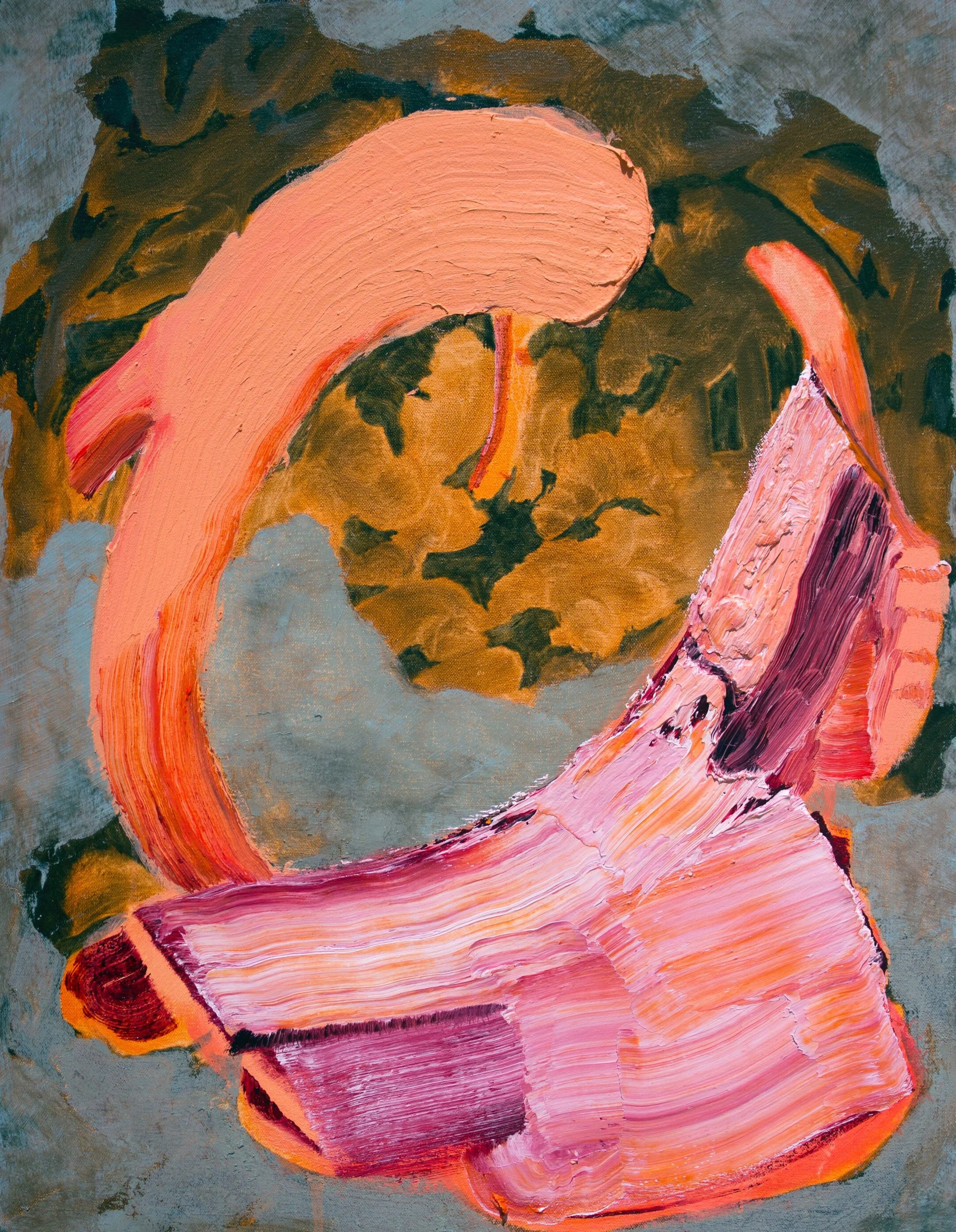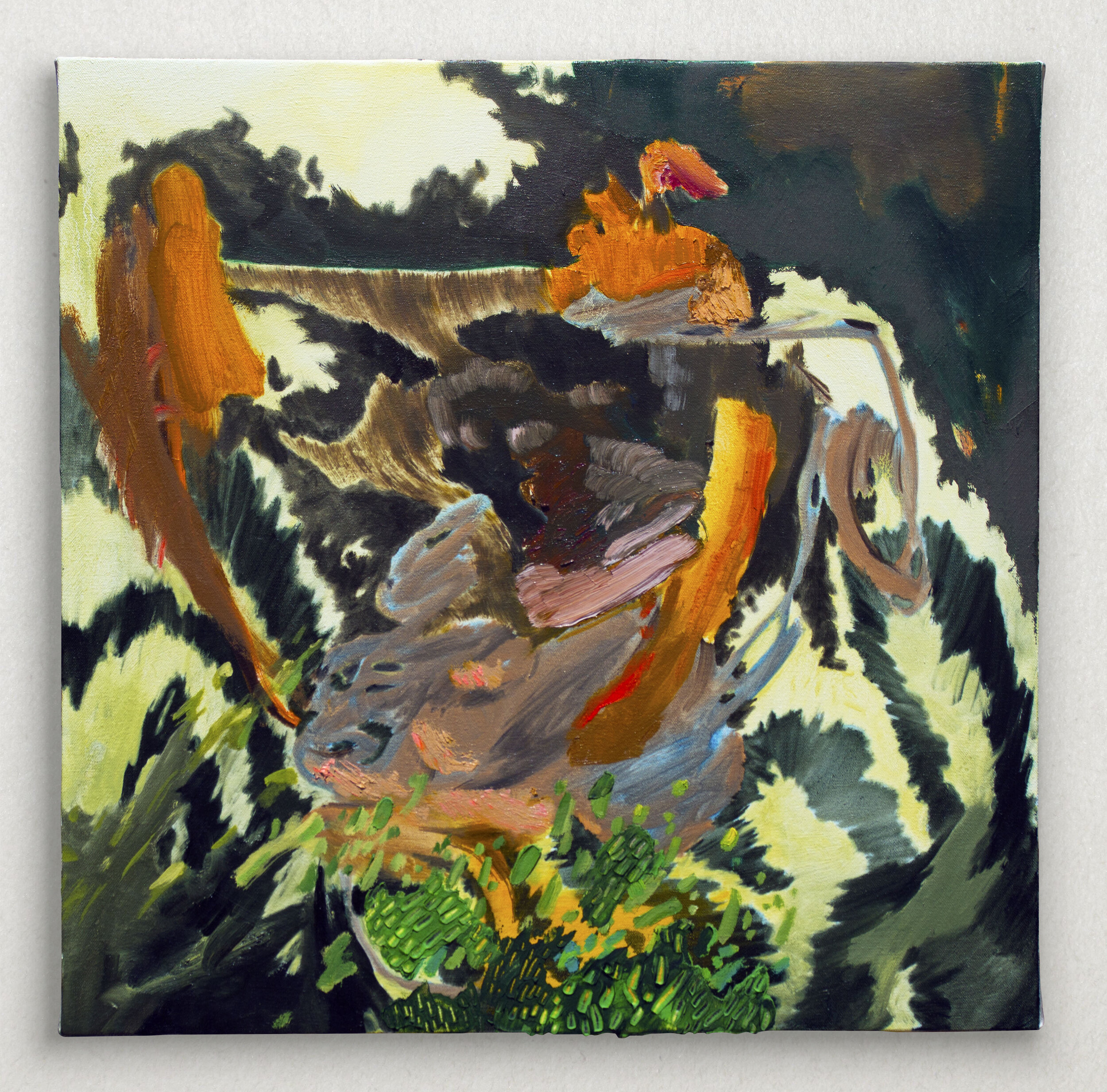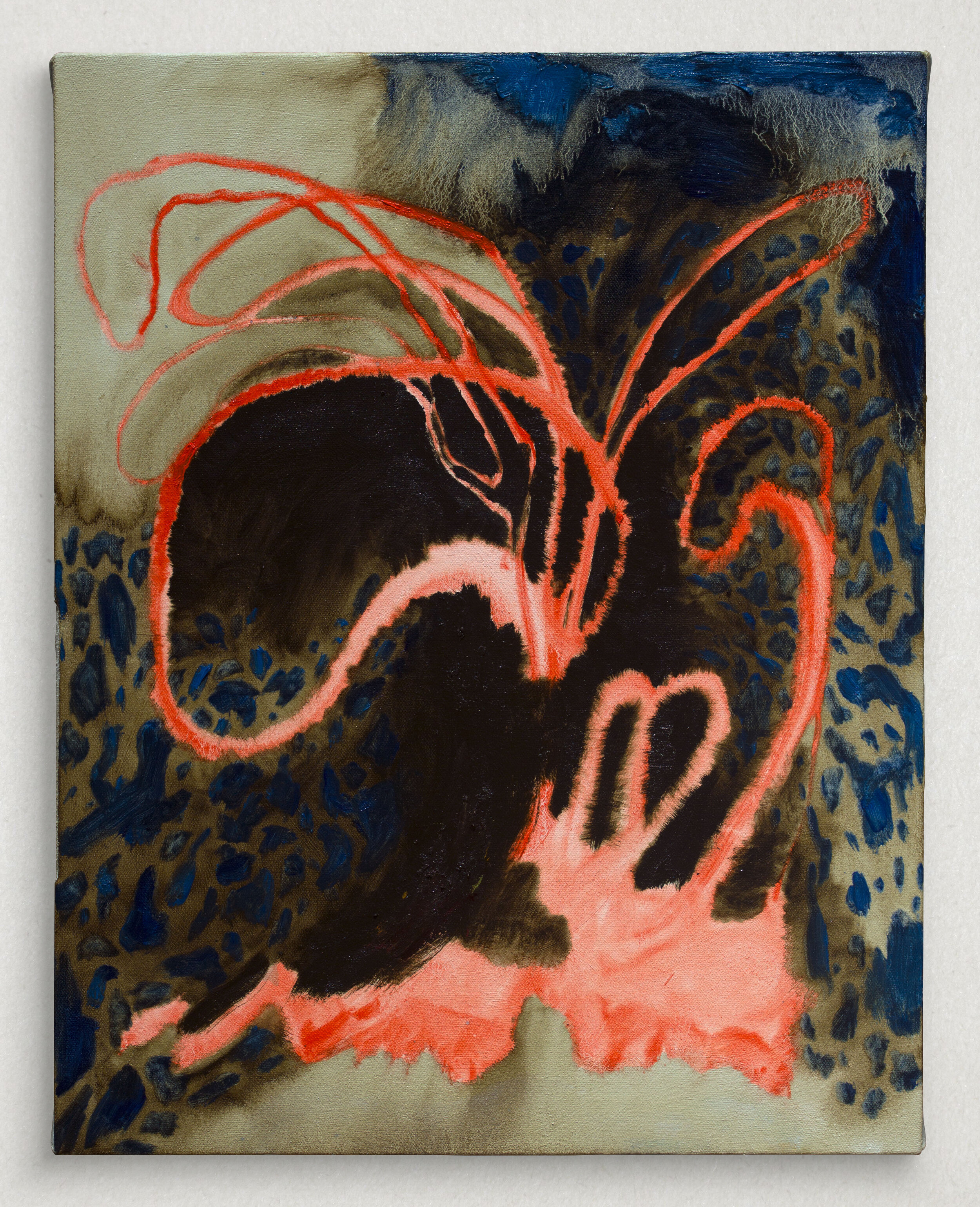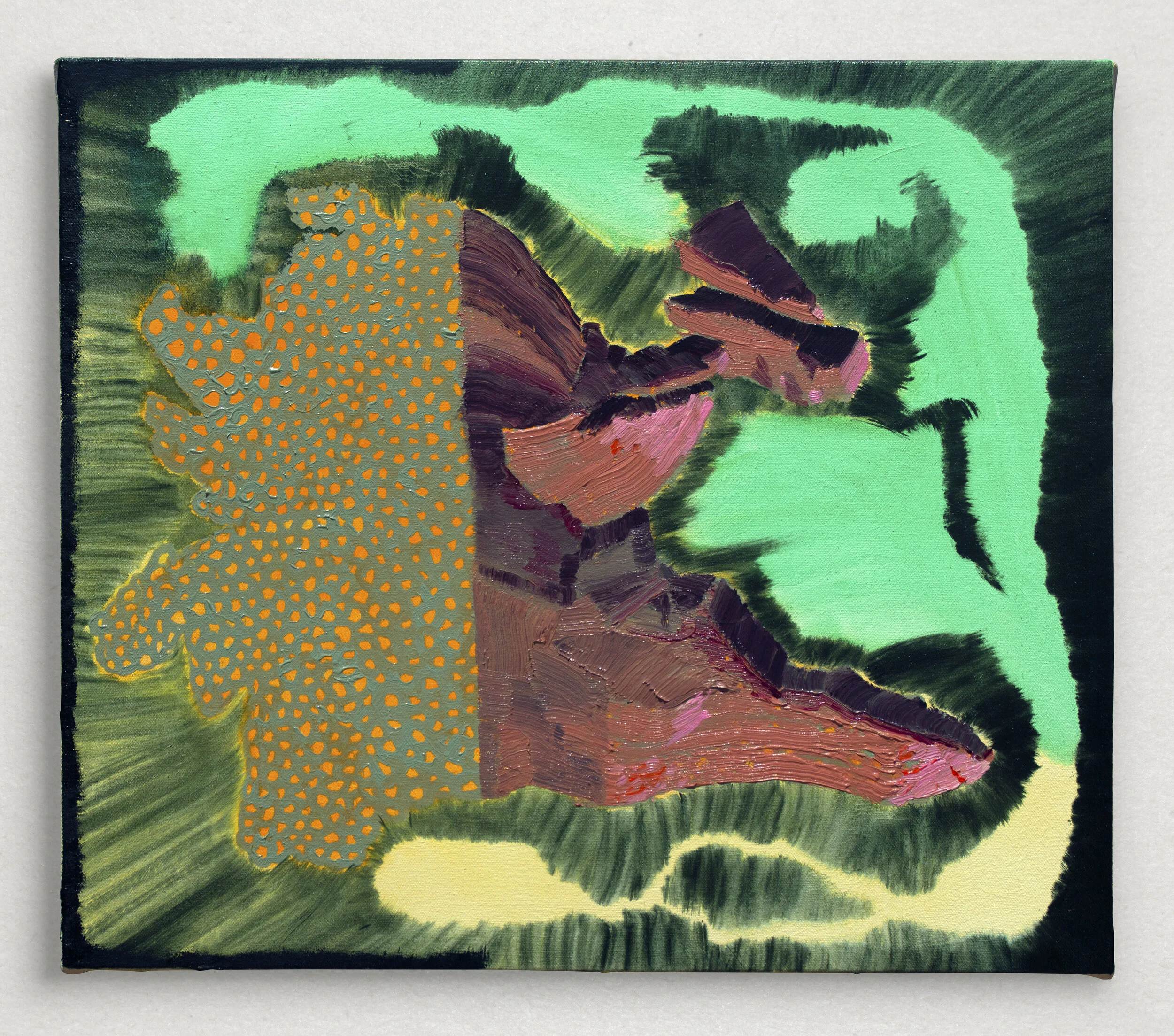Interview with Michael Nauert
Michael Nauert
Idea as Angel, 2019
Oil on canvas
18.25 x 24.25
Michael Nauert, born and working in Southern California, creates abstract oil paintings based on nature, resonance, and mind-space. We are pleased to publish his work in Volume 10. In this interview, he sits down with Diana Cerezino, a Lisbon-based artist and founder of PADA Studios to discuss his work, process, and inspirations.
Diana: How did you start painting?
Michael: I drew for about a year before I started painting. At the time, I was 18 and in between transferring to a different music school, so I took a drawing class for fun at a community college. My teacher, Jason Eoff, turned out to be an amazing teacher. He brought us to one of the biggest artist communities in LA, and I got to see art was more than a commissioned portrait of your grandma with her dog. My only idea of art back then was based on cheap kitsch work, but in class I got a good taste of contemporary art history. Jason was a wizard at subverting ideas of drawing through process, resulting in work I never expected I could make. Once classes ended, I bought canvases and craft paint from the 99 cent store. My drawings naturally flowed into painting.
Diana: How important is music in your practice and how does it influence you as an artist? Is there a correlation between music and your art practice?
Michael: Music started when I was 8, and is my whole childhood. I obsessed over playing trumpet and piano, and even started a music degree in university. That ended tragically and became a force that drove me into art. Music has a huge impact on how I perceive, so when it comes to content and process within my art, music will always be there in some form.
That experience has translated into my painting innately. It’s taken me a while to start seeing it, and I still feel I only understand the interaction in part. For me, the interaction between the mind and the body is the part that is musical. Being able to hold or feel something within the mind while expressing it onto the canvas becomes a type of resonance. With the continuum of thought, the resonance between mind and body is always changing through harmony and dissonance, so during the time frame of making a painting that resonance between mind and body has to be chased and discovered over and over. It is similar to a song continually finding variations and contrasts to present harmony and dissonance.
Diana: Living in the desert in California, how does this inform your work?
Michael: When I lived in Chicago I wondered why I would use certain colors or make atmospheric spaces in my paintings. I missed California, so when I moved back to the expansive space of the desert I got to see the neon sunsets and those colors filter everything they touched. Knowing I had the same colors and operations as the sunset, made me realize growing up in California is where I learned color and spatial structure from.
Diana: You mentioned converting a camping car to allow you to travel into nature and to work in your paintings surrounded by environments that inspire you. Have you worked that way before and how did it impact the paintings?
Michael: Growing up, my family would do road trips out into nature where my dad would teach my siblings and me how to hunt for gems, minerals, and fossils and how to collect butterflies. I believe a lot of my visual learning came out of that focus into discerning small details while exploring the beautiful landscapes.
The first time I found nature and art together was when I attended Oxbow School of Art in 2015. The campus is made of old cabins in a forest off the edge of a lagoon. Working this way, in the midst of nature, allowed me to be present. In the city I was painting from my memories of landscapes or in my longing to return to them. I think that just involves more interaction between resonance within myself because it all has to do with memory, but when I’m in the space I’m inspired by, I can allow for resonance between mind, body, and location. Connecting with a location gives a type of rest in some of the painting choices. Instead of conjuring up color relationships, forms, and spaces, I can collect them as I explore my surroundings.
Diana: We spoke about ideas of resonance and dissonance. How does this inform your practice?
Michael: I see resonance as a connection to something resulting in a type of duplication. When there is sound resonation it means a neighboring object is also vibrating the same notes. So as I connect to various harmonies and dissonances, I can resonate them through the act of painting.
I think harmony and dissonance are a great replacement for good and bad art because they offer a function. Harmony is when two wave’s lengths can fit into each other, there’s an inherent agreement between them. The function is a peace and rest. Dissonance is the opposite and there is an inherent disagreement between the waves. The function is a conflict and motion. What would a song be without the tension dissonance uses to create expectation and the desire for the climax? And how would you enjoy the climax without harmony?
I find dissonance in the process of each painting and in seasons of my painting practice. When I make a ton of bad work or I don’t like what I’m doing in a particular painting I see dissonance at work. In one sense, I am holding two ideas that don’t mesh, continually rebounding them off each other until I move into a territory I haven’t been before. In another sense, when I finish a painting I’m not into, it can be that I’m not ready to accept the ideas the painting carries. I’m still in the mindset of dissonance, my mind acting as one wave and the painting as a conflicting wave. Thinking about some of my work and process as dissonant I am able to see a function in it. Then I can be aware of where the dissonance leads. I can then also create my own dissonance within the paintings to cause motion.
Diana: You saw Hilma af Klint’s paintings at the Gugenheim. Hilma Af Klint is one of the first western abstract painters and her work is fascinating, creating paintings and diagrams to represent complex ideas. How did seeing her work influenced you?
Michael: Bringing my terms and interests in music to her story gave me a space to help think about resonance and its functions in my own work. Hilma is a great example of someone who was able to resonate something that was dissonant to her time. She marked most of her works as paintings for the future because so many people from her time couldn’t accept what she was making. With that foresight, she held her audience in mind. I like that interaction that comes with the audience being so important to the work’s success. The right audience was needed to resonate her paintings, duplicating in themselves what her generation could not.
She has these groupings of abstract forms that seem to be their own world, even apart from the paintings. I think this distinction of the groupings from their painting happened for me because a lot of them appeared to me only in person. In books, many groupings become too small to see. She also distinguished them in her journals where she interprets each abstract form, turning them into symbols. It seemed that she was trying to find out what would resonate in the viewers of the future as they experience each piece of her paintings.
I like the idea of holding something in order to resonate it onto the canvas, and then the canvas resonating ideas in the viewer. The canvas becomes this intersection of connection between Hilma, abstract forms, and the viewers, even viewers with each other.
I also love her two commandments:
1. To always paint intuitively
2. To only know in part
Diana: You say you do not plan your paintings beforehand but sense them noetically. Your process is intuitive and improvisational. Can you expand this idea more?
Michael: I say noetic because it feels like the painting already exists, like it knows what it wants to be. I start the painting with an obsession over a simple color, form, or type of application that turns into a need to apply it onto canvas. The process is not a replication, but a communication. The idea has a language that talks to me, to create an outcome I’m not completely aware of. Through this communication the painting feels as though it were alive. The metrics of instinct to form lies in an idea having its own language. When the idea is manifested onto a canvas it is called a painting.
Even though a representation exists in my head, what I carry out is always unexpected. Each choice of the painting starts the process over. Holding the results recorded on the canvas against the instinctual template, I can then find my next obsession, and thereby continue painting.
Diana: What are the ideas behind the series ‘Angelic Linguistics’?
Michael: There’s an old notion that angels are just ideas floating in the ether waiting to embody a prepared mind. I often think of some of the abstract marks on my paintings in this way — that they are idea filled forms waiting to embody a ready consciousness. I don’t think the idea-forms are dualistic, where they can be defined as something and not something else. They are subjective. The idea-forms connect infinitely to webs of thought-spaces to be explored. They become concepts in the realm of the felt intellect, ideas that permeate the mind through experiencing.
It is the mirror process of the question I answered above. An idea communicates prompts for me to generate specific forms, and then the specific forms communicate experiences to the viewer in order to generate an idea. The ability for an idea or a form to communicate animates it, giving it a sense of spirit. That is, until the mystery dissolves with understanding of something once unexpected. Or perhaps we empower the idea or form with language through our own intuitions.





